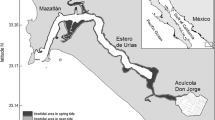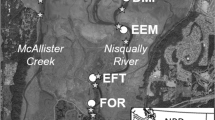Abstract
Because many natural waterbird habitats are threatened by human disturbance and sea level rise, it is vitally important to identify alternative wetlands that may supplement declining natural habitats. Coastal salinas are anthropogenic habitats used for obtaining salt by evaporation of sea water. These habitats support important numbers of waterbirds around the world, but their importance as feeding habitats is poorly understood. I evaluated salinas as feeding habitats relative to natural intertidal habitats by comparing time spent foraging, prey-size selection, and net energy intake rate of four overwintering small-sized shorebird species on intertidal mudflats and on adjacent salinas. In winter, Dunlin Calidris alpina, Curlew Sandpiper C. ferruginea and Sanderling C. alba predominantly used the mudflats, whereas Little Stint C. minuta fed mainly on the salina. In the pre-migration fattening period, all species preferred to feed on the salina, significantly increasing the time they spent feeding in the supratidal pans. Net energy intake rates (kJ min−1) were significantly higher on the salina than on the intertidal mudflats in 60% of all comparisons. On average, salina contributed 25.2 ± 24.2% (range: 4–54%) of the daily consumption in winter and 78.7 ± 16.4% (range: 63–100%) of the daily consumption in the pre-migration period. I recommend that modern active salinas maintain flooding conditions in the evaporation pans throughout winter, thus increasing the available surface for foraging waterbirds. I conclude that the conservation of salinas at coastal wetlands is a viable approach for shorebird conservation.
Similar content being viewed by others
References
Bart J., Fligner M.A. and Notz I.W. 2000. Sampling and Statistical Methods for Behavioural Ecologists. Cambridge University Press, Cambridge, UK.
Britton R.H. and Johnson A.R. 1987. An ecological account of a Mediterranean salina: the salin de Giraud, Camargue (S. France). Biological Conservation 42: 185–230.
Carmona R. and Danemann G. 1998. Spatiotemporal distribution of birds at the Guerrero Negro saltworks, Baja California Sur, Mexico. Ciencias Marinas 24: 389–408.
Castro G., Stoyan N. and Myers P. 1989. Assimilation efficiency in birds: a function of taxon or food type? Comparative Biochemistry and Physiology 92A: 271–278.
Castro M. 2000. Ecología de la alimentación en el Chorlitejo patinegro Charadrius alexandrinus: existe plasticidad comportamental y fisiológica asociada al sexo?, Ph.D. Thesis, Cádiz University, Spain.
Collazo J.A., Harrington B.A., Grear J.S. and Colon J.A. 1995. Abundance and distribution of shorebirds at the Cabo Rojo salt flats, Puerto Rico. Journal of Field Ornithology 66: 424–438.
Dekinga A. and Piersma T. 1993. Reconstructing diet composition on the basis of faeces in a mollusceating wader, the Knot Calidris canutus. Bird Study 40: 144–156.
Dolman P.M. and Sutherland W.J. 1995. The response of bird populations to habitat loss. Ibis 137: S38–S46.
Elphick C.S. 2000. Functional equivalency between rice fields and seminatural wetland habitats. Conservation Biology 14: 181–191.
Elphick C.S. and Oring L.W. 1998. Winter management of California rice fields for waterbirds. Journal of Applied Ecology 35: 95–108.
Ens B.J. and Goss-Custard J.D. 1984. Interference among Oystercatchers Haematopus ostralegus feeding on mussels, Mytilus edulis, on the Exe estuary. Journal of Animal Ecology 53: 217–231.
Fasola M. and Ruiz X. 1996. The value of rice fields as substitutes for natural wetlands for waterbirds in the Mediterranean region. Colonial Waterbirds 19: 122–128.
Goss-Custard J.D. 1977. Optimal foraging and the size selection of worms by Redshank, Tringa totanus, in the field. Animal Behaviour 25: 10–29.
Goss-Custard J.D. and Sutherland W.J. 1997. Individual behaviour, populations and conservation. In: Krebs J.R. and Davies N.B. (eds), Behavioural Ecology an Evolutionary Approach. 4th edn. Blackwell Science Ltd, Oxford, UK, pp. 373–395.
Goss-Custard J.D., Caldow R.W.G., Clarke R.T., Durell SEA le V dit, Urfi J. and West A.D. 1994. Consequences of habitat loss and change to populations of wintering migratory birds: predicting the local and global effects from studies of individuals. Ibis 137: S56–S66.
Goss-Custard J.D., Caldow R.W.G., Clarke R.T., Durell SEA le V dit and Sutherland W.J. 1995. Deriving population parameters from individual variations in foraging behaviour: I. Empirical game theory distribution model of oystercatchers Haematopus ostralegus feeding on mussels Mytilus edulis. Journal of Animal Ecology 64: 265–276.
Hamilton L.C. 1990. Modern Data Analysis: A First Course in Applied Statistics. Brooks/Cole, Pacific Grove, California.
Hortas F. 1997. Evolución de la comunidad de aves limícolas (Orden Charadriiformes) en salinas del suroeste de España. Estructura espacio-temporal de las poblaciones y uso del hábitat, Ph.D. Thesis, Cádiz University, Spain.
Howe M.A., Geissler P.H. and Harrington B.A. 1989. Population trends of North American shorebirds based on the International Shorebird Survey. Biological Conservation 49: 185–199.
Hulbert S.H. 1984. Pseudoreplication and design of ecological field experiments. Ecological Monographs 54: 87–211.
Kalejta B. 1993. Diets of shorebirds at the Berg River estuary, South Africa: spatial and temporal variation. Ostrich 64: 123–133.
Lee N.M. and Hockey P.A.R. 2001. Biases in the field estimation of shorebird prey species. Journal of Field Ornithology 72: 49–61.
Martin A.P. and Randall R.M. 1987. Numbers of waterbirds at a commercial saltpan, and suggestions for management. South African Journal of Wildlife Research 17: 75–81.
Masero J.A. 2002. Why don't Red Knots Calidris canutus feed extensively on the crustacean Artemia? Bird Study 49: 304–306.
Masero J.A. and Pérez-Hurtado A. 2001. Importance of the supratidal habitats for maintaining overwintering shorebird populations: how Redshanks use tidal mudflats and adjacent saltworks in southern Europe. Condor 103: 21–30.
Masero J.A., Pérez-González M., Basadre M. and Otero-Saavedra M. 1999. Food supply for waders (Aves: Charadrii) in an estuarine area in the Bay of Cádiz (SW Iberian Peninsula). Acta Oecologica 20: 429–434.
Masero J.A., Pérez-Hurtado A., Castro M. and Arroyo G.M. 2000. Complementary use of intertidal mudflats and adjacent salinas by foraging waders. Ardea 88: 179–191.
Milsom T.P., Langton S.D., Parkin W.K., Peel S., Bishop J.D., Hart J.D. et al. 2000. Habitat models of bird species' distribution: an aid to the management of coastal grazing marshes. Journal of Applied Ecology 37: 706–727.
Moreira F. 1994a. Diet, prey size selection and intake rates of Black-tailed Godwits Limosa limosa feeding on mudflats. Ibis 136: 349–355.
Moreira F. 1994b. Diet and feeding rates of Knots Calidris canutus in the Tagus estuary (Portugal). Ardea 82: 133–136.
Myers J.P., Morrison R.G., Antas P.Z., Harrington B.A., Lovejoy T.E., Sallaberry M. et al. 1987. Conservation strategy for migratory species. American Scientist 75: 19–26.
Nagy K.A. 1987. Field metabolic rate and food requirement scaling in mammals and birds. Ecological Monographs 57: 111–128.
Pérez-Hurtado A., Hortas F., Ruiz F. and Solís F. 1993. Importancia de la Bahía de Cadiz para las poblaciones de limícolas invernantes e influencia de las transformaciones humanas. Ardeola 40: 133–142.
Pettiford R.A., Caldow R.W.G., Rowcliffe J.M., Goss-Custard J.D., Black J.M., Hodder K.H. et al. 2000. Spatially explicity, individual-based, behavioural models of the annual cycle of two migratory goose populations. Journal of Animal Ecology 37: 103–135.
Pfister C., Kasprzyk M.J. and Harrington B. 1998. Body-fat levels and annual return in migrating semipalmated sandpipers. The Auk 115: 904–915.
Piersma T., De Goeij P. and Tulp I. 1993a. An evaluation of intertidal feeding habitats from a shorebird perspective: towards relevant comparisons between temperate and tropical mudflats. Netherlands Journal of Sea Research 31: 503–512.
Piersma T., Hoekstra R., Dekinga A., Koolhaas A., Wolf P., Battley P. et al. 1993b. Scale and intensity of intertidal habitat use by Knots Calidris canutus in the westernWadden Sea in relation to food, friends and foes. Netherlands Journal of Sea Research 31: 331–357.
Piersma T., Van Gils J. and Wiersma P. 1996. Family Scolopacidae (sandpipers, snipes and phalaropes). In: Del Hoyo J., Elliott A. and Sargatal J. (eds), Handbook of the Birds of the World Vol. 3. Lynx Editions, Barcelona, Spain, pp. 444–533.
Rubega M. and Inouye C. 1994. Prey switching in Red-Necked Phalaropes Phalaropus lobatus: feeding limitations, the functional response and water management at Mono Lake, California. Biological Conservation 70: 205–210.
Rufino R. and Neves R. 1992. The effects on wader populations of the conversion of salinas into fish farms. In: Finlayson M., Hollis T. and Davis T. (eds), Managing Mediterranean Wetlands and their Birds. IWRB special publication number 20. IWRB, Slimbridge, UK, pp. 177–182.
Sadoul N., Walmsley J. and Charpentier B. 1998. Salinas and Nature Conservation. Conservation of Mediterranean Wetlands, number 9. MedWet /Tour du Valat Publications, Arles, France.
Stephens J.R. and Krebs J.R. 1986. Foraging Theory. Princeton University Press, Princeton, New Jersey.
Tripp K.J. and Collazo J.A. 1997. Non-breeding territoriality of Semipalmated Sandpipers. The Wilson Bulletin 109: 630–642.
Turpie J.K. and Hockey P.A.R. 1993. Comparative diurnal and nocturnal foraging behaviour and energy intake rate of premigratory Grey Plovers Pluvialis squatarola and Whimbrels Numenius phaeopus in South Africa. Ibis 135: 156–165.
Velasquez C.R. 1992. Managing artificial saltpans as a waterbird habitat: species' responses to water level manipulations. Colonial Waterbirds 15: 43–55.
Velasquez C.R. and Hockey P.A.R. 1992. The importance of supratidal foraging habitats for waders at a south temperate estuary. Ardea 80: 243–253.
Velasquez C.R., Kalejta B. and Hockey P.A.R. 1991. Seasonal abundance, habitat selection and energy consumption of waterbirds at the Berg river estuary, South Africa. Ostrich 62: 109–123.
Verkuil Y., Koolhaas A. and Van Der Winden J. 1993. Wind effects on prey availability: how northward migrating waders use brackish and hypersaline lagoons in the Sivash, Ukranie. Netherlands Journal of Sea Research 31: 359–374.
Warnock S.E. and Takekawa J.Y. 1995. Habitat preferences of wintering shorebirds in a temporally changing environment: Western Sandpipers in the San Francisco Bay estuary. The Auk 112: 920–930.
Warnock S.E. and Takekawa J.Y. 1996. Wintering site fidelity and movement patterns of Western Sandpipers Calidris mauri in the San Francisco Bay estuary. Ibis 118: 160–167.
Weber T.P., Houston A.I. and Ens B. 1999. Consequences of habitat loss at migratory stopover sites: a theoretical investigation. Journal of Avian Biology 30: 416–426.
Williams G. and Hall M. 1987. The loss of coastal grazing marshes in south and east England, with special reference to east Essex, England. Biological Conservation 39: 243–253.
Worrall D.H. 1984. Diet of the Dunlin Calidris alpina in the Severn estuary. Bird Study 31: 203–212.
Young L. 1998. The importance to ardeids of the Deep Bay fish ponds, Hong Kong. Biological Conservation 84: 293–300.
Young L. and Chan G. 1997. The significance of drained fish ponds for wintering waterbirds at the Mai Po Marshes, Hong Kong. Ibis 139: 694–697.
Zwarts L. and Blomert A.-M. 1990. Selectivity of Whimbrels feeding on fiddler crabs explained by component specific digestibilities. Ardea 78: 193–208.
Zwarts L. and Wanink J.H. 1993. How the food supply harvestable by waders in the wadden sea depends on the variation in energy density, body weight, biomass, burying depth and behaviour of tidal-flats invertebrates. Netherlands Journal of Sea Research 31: 441–476.
Zwarts L., Blomert A.-M., Ens B., Hupkes R. and Van Spanje T.M. 1990a. Why do waders reach high feeding densities on the intertidal flats of the Banc d'Arguin, Mauritania? Ardea 78: 39–52.
Zwarts L., Blomert A.-M. and Hupkes R. 1990b. Increase of feeding time in waders preparing for spring migration from the Banc d'Arguin, Mauritania. Ardea 78: 237–256.
Zwarts L., Cayford J.T., Hulscher J.B., Kersten M., Meire P.M. and Triplet P. 1996. Prey size selection and intake rate. In: Goss-Custard J.D. (ed.), Oystercatcher: From Individuals to Populations. Oxford University Press, Oxford, UK, pp. 30–55.
Zwarts L., Ens B.J., Kersten M. and Piersma T. 1990c. Moult, mass and flight range of waders ready to take off for long-distance migrations. Ardea 78: 339–364.
Author information
Authors and Affiliations
Rights and permissions
About this article
Cite this article
Masero, J.A. Assessing alternative anthropogenic habitats for conserving waterbirds: salinas as buffer areas against the impact of natural habitat loss for shorebirds. Biodiversity and Conservation 12, 1157–1173 (2003). https://doi.org/10.1023/A:1023021320448
Issue Date:
DOI: https://doi.org/10.1023/A:1023021320448




